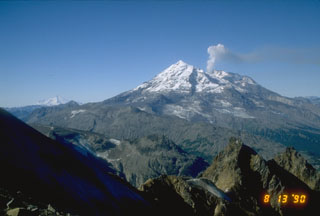Report on Redoubt (United States) — 11 March-17 March 2009
Smithsonian Institution / US Geological Survey
Weekly Volcanic Activity Report, 11 March-17 March 2009
Managing Editor: Sally Sennert.
Please cite this report as:
Global Volcanism Program, 2009. Report on Redoubt (United States) (Sennert, S, ed.). Weekly Volcanic Activity Report, 11 March-17 March 2009. Smithsonian Institution and US Geological Survey.
Redoubt
United States
60.485°N, 152.742°W; summit elev. 3108 m
All times are local (unless otherwise noted)
AVO reported that during 11-15 March seismic activity at Redoubt was low but remained above background levels. On 12, 14, and 15 March clear web camera views showed steam plumes that rose just above the summit. At about 1305 on 15 March, seismic activity increased and about four hours of volcanic tremor ensued. AVO scientists aboard an overflight saw a steam-and-ash plume rise to an altitude of 4.6 km (15,000 ft) a.s.l. and produce minor ashfall on the summit crater floor and down the S flank. The emissions originated from a new vent, located just S of the 1990 lava dome and W of the prominent ice collapse feature near the N edge of the summit crater. About twenty minutes later, a sediment-laden flow occurred from a small area in the ice on the upper part of Drift glacier. Steam plumes were later noted. AVO raised the Aviation Color Code to Orange and the Alert Level to Watch. Clear web camera views on 17 March showed no unusual activity.
Geological Summary. Redoubt is a glacier-covered stratovolcano with a breached summit crater in Lake Clark National Park about 170 km SW of Anchorage. Next to Mount Spurr, Redoubt has been the most active Holocene volcano in the upper Cook Inlet. The volcano was constructed beginning about 890,000 years ago over Mesozoic granitic rocks of the Alaska-Aleutian Range batholith. Collapse of the summit 13,000-10,500 years ago produced a major debris avalanche that reached Cook Inlet. Holocene activity has included the emplacement of a large debris avalanche and clay-rich lahars that dammed Lake Crescent on the south side and reached Cook Inlet about 3,500 years ago. Eruptions during the past few centuries have affected only the Drift River drainage on the north. Historical eruptions have originated from a vent at the north end of the 1.8-km-wide breached summit crater. The 1989-90 eruption had severe economic impact on the Cook Inlet region and affected air traffic far beyond the volcano.
Source: US Geological Survey Alaska Volcano Observatory (AVO)

